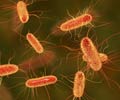Scientists have come up with a new way to watch bacteria as they swim, which is expected to eventually help trap Escherichia coli bacteria and modify the microbes' environment without
Scientists have come up with a new way to watch bacteria as they swim, which is expected to eventually help trap Escherichia coli bacteria and modify the microbes' environment without hindering the way they move.
The new approach uses optical traps, microfluidic chambers and fluorescence to get an improved picture of how E. coli get around.Yann Chemla, a professor of Physics at the University of Illinois, says that the microfluidic chambers provide a controlled environment in which the bacteria swim, and allow them to introduce specific stimuli - such as chemical attractants - to see if the microbes change direction in response to that stimulus.
Chemla, who jointly led the study with physics professor Ido Golding, further says that optical traps use lasers to confine individual cells without impeding their rotation or the movement of their flagella.
The researcher calls the optical traps "bacterial treadmills".
According to the researchers, movement of the bacterial cell alters the light from the laser, and, thereby, help track its behaviour.
Fluorescent markers enhance visualization of the bacteria and their flagella under a microscope, say the researchers.
Advertisement
"For example, some people have asked whether E. coli has a nose. Does it have a front and back?" Nature magazine quoted Golding as saying.
Advertisement
The researchers found that after most tumbles, a bacterium usually continued swimming in the same general direction, but that about one in six tumbles caused it to change direction completely.
They were also able to quantify other features of bacterial swimming, such as changes in velocity and the time spent running and tumbling.
They hope that their novel method will allow scientists to address many more questions about this model organism.
"That's the typical way biology moves forward. You develop a new measurement capability and then you can use that to go back and look at fundamental questions that people had been looking at but had no way of answering," Golding said.
A research article describing the new technique has been published in the journal Nature Methods.
Source-ANI










